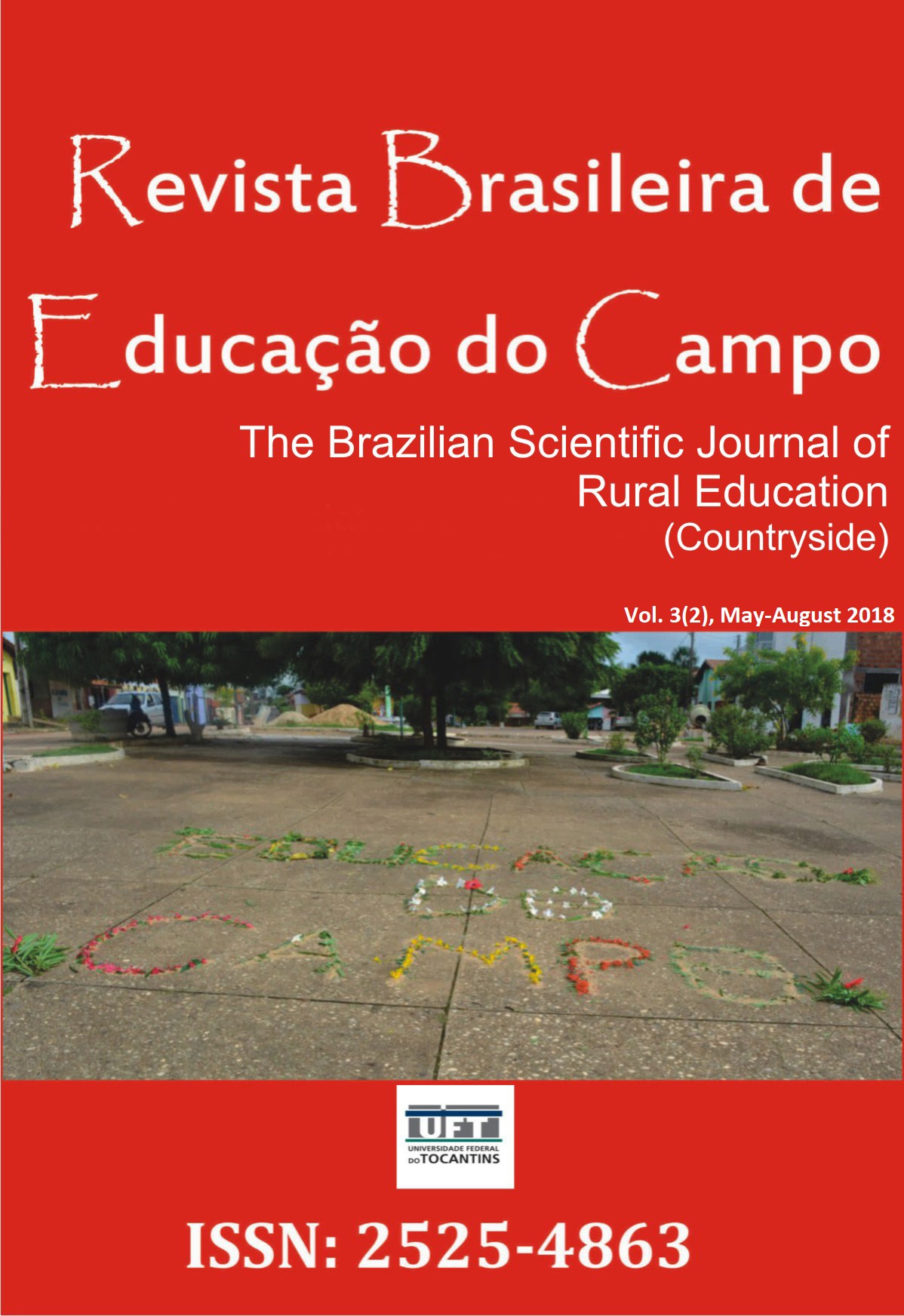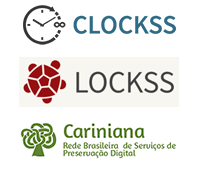Countryside Education, High School Education and Peasant youth: Construction concepts
DOI:
https://doi.org/10.20873/uft.2525-4863.2018v3n2p578Keywords:
Countryside education, high countryside education, peasant youth.Abstract
ABSTRACT. This article discusses the configurations on high school education on countryside schools of the branch CEFAPRO of São Félix do Araguaia-MT, in coherence with the proposal of this method. The investigation was made with teachers of two schools/classrooms, located in the project of settlement Mata Azul and the project of settle med Dom Pedro Casaldáliga, that connected to the state schools September 29th, in the municipality of Novo Santo Antônio, and Tancredo Neves, in the municipality of São Félix de Araguaia, in the micro region of the North Araguaia - on the north east of Mato Grosso. It was used an approach qualitative investigation, in a critical-dialectic perspective for emphasis on the historical dimensions and transforming of the situations or student phenomena. For the gather of information was used interviews half structured. It was contacted that high school education on the countryside that were part of this studies are still incipient, that includes questions about the structures about the school modeling, to the curricular organization, to the important work of this schools, to the formation of teachers, to the access and the permanence of this students until they completed their high school, showing us the tension by part of the teachers, as far as they set off the paradigm of selection and duality of high school education and the urban centrism in the countryside.
Downloads
References
Brasil. (1996). Presidência da República. Lei de Diretrizes e Bases da Educação Nacional nº 9.394, de 20 de dezembro de 1996. Diário Oficial [da República Federativa do Brasil]. Brasília, 30 de dezembro de 1996.
Brasil. (2005). Ministério da Educação e Cultura. Secretaria de Educação Continuada, Alfabetização e Diversidade. Referências para uma política nacional de educação do campo: caderno de subsídios. Coordenação: Marise Nogueira Ramos, Telma Maria Moreira, Clarice Aparecida dos Santos – 2 ed. – Brasília, DF: MEC, SECAD.
Brasil. (2012). Conselho Nacional de Educação. Resolução n. 2, de 30 de janeiro de 2012. Define Diretrizes Curriculares Nacionais para o Ensino Médio. Brasília, DF: CNE.
Brasil. (2013). Presidência da República. Lei nº 12.858, de 9 de setembro de 2013. Diário Oficial [da República Federativa do Brasil]. Brasília - DF, terça-feira, 10 de setembro de 2013.
Caldart, R. S. (2015). Caminhos para transformação da escola. In Caldart, R. S., Stédile, M. E., & Daros, D. (Orgs.) Caminhos para transformação da escola: agricultura camponesa, educação politécnica e escolas do campo (pp. 115-138). São Paulo, SP: Expressão Popular.
Carneiro, M. J. (2011). Juventude rural: projetos e valores. In Abramo, H. W., & Branco, P. P. M. (Orgs.). Retratos da juventude brasileira: análises de uma pesquisa nacional (pp. 243- 261). São Paulo, SP: Instituto Cidadania/Editora Fundação Perseu Abramo.
Castro, E. G. (2009). Juventude rural no Brasil: processos de exclusão e a construção de um ator político. Revista Latinoamericana de Ciencias Sociales, Niñez y Juventud, 7(1), 179-208.
Dayrell, J. (1996). A escola como espaço sócio-cultural. In Dayrell, J. (Org.) Múltiplos olhares sobre educação e cultura (pp. 136-161). Belo Horizonte, MG: UFMG.
Dayrell, J., & Carrano, P. (2014). Juventude e ensino médio: quem é este aluno que chega à escola. In Dayrell, J., Carrano, P., & Maia L. C. (Orgs.). Juventude e Ensino Médio (pp. 101- 133). Belo Horizonte, MG: Editora UFMG.
Freitas, L. C. (2012). Escola Única do Trabalho. In Caldart, R. S., Pereira, I. B., Alentejano, P., & Frigotto, G. (Orgs.). Dicionário da Educação do Campo (pp. 339-343). Rio de Janeiro, São Paulo: Escola Politécnica de Saúde Joaquim Venâncio, Expressão Popular.
Frigotto, G. (2016). Escola sem Partido. Recuperado de: https//espacoacademico.wordpress.com/2016/06/29/escola-sem-partido-imposicao-da-mordaca-aos-educadores/
Gamboa, S. S. (1998). Epistemologia da Pesquisa em Educação. Campinas, SP: Práxis, 1998.
Garcia, S., & Moll, J. (2014). Juventude e ensino médio: sujeitos e currículos em diálogo. In Dayrell, J., Carrano, P., & Maia, C. L. (Orgs.). Juventude e Ensino Médio (pp. 7-9). Belo Horizonte, MG: Editora UFMG.
Kolling, E. J., Nery, I., & Molina, M. C. (Orgs.). (1999). Por Uma Educação do Campo (Memória). Brasília, DF: Editora Universidade de Brasília (vol. 1).
Machado, I. F. (2012). Relação Trabalho – Educação em escolas do Campo. In: Kassar, M. C.; Silva, F. C. T. (Orgs.). Educação e Pesquisa no Centro-Oeste: políticas públicas e formação humana (pp. 267-282). Campo Grande, MS: Editora UFMS.
Mészáros, I. (2005). A Educação para Além do Capital. São Paulo, SP: Boitempo Editorial.
Projeto Político Pedagógico da Escola Estadual 29 de Setembro, Novo Santo Antônio, Mato Grosso, 2014.
Rodrigues, R. (2010). O Ensino Médio no Brasil: da invisibilidade à onipresença. In Caldart, R. S., Fetzner, A. R., Rodrigues, R., & Freitas, L. C. (Orgs.). Caminhos para transformação da escola: reflexões desde práticas da licenciatura em educação (pp. 179-207). São Paulo: Expressão Popular.
Published
How to Cite
Issue
Section
License
Proposal for Copyright Notice Creative Commons
1. Policy Proposal to Open Access Journals
Authors who publish with this journal agree to the following terms:
A. Authors retain copyright and grant the journal right of first publication with the work simultaneously licensed under the Creative Commons Attribution License that allows sharing the work with recognition of its initial publication in this journal.
B. Authors are able to take on additional contracts separately, non-exclusive distribution of the version of the paper published in this journal (ex .: publish in institutional repository or as a book), with an acknowledgment of its initial publication in this journal.
C. Authors are permitted and encouraged to post their work online (eg .: in institutional repositories or on their website) at any point before or during the editorial process, as it can lead to productive exchanges, as well as increase the impact and the citation of published work (See the Effect of Open Access).















